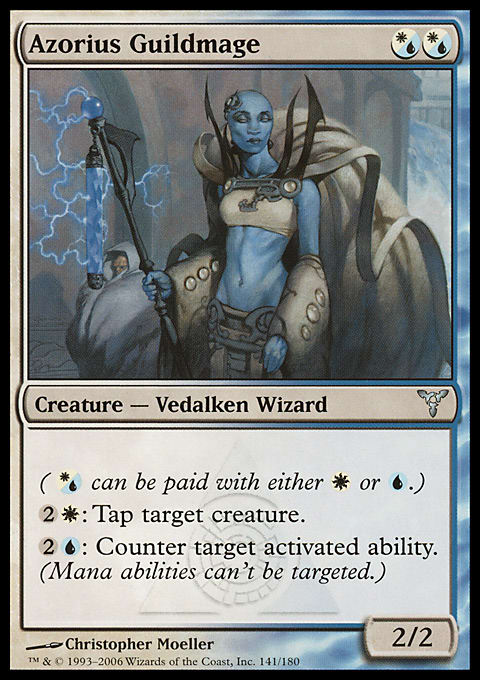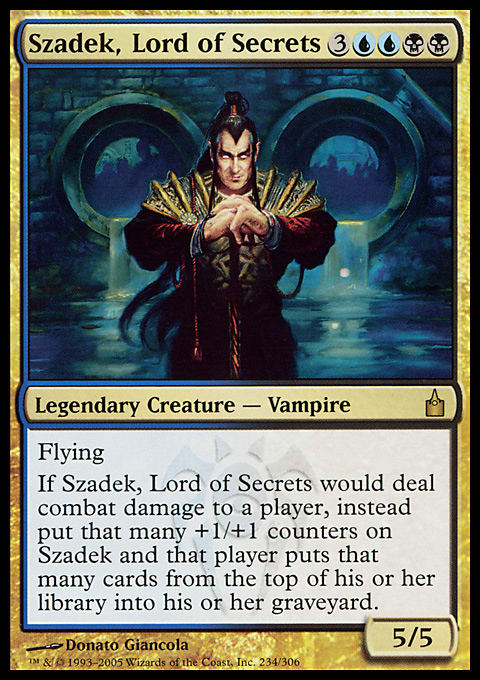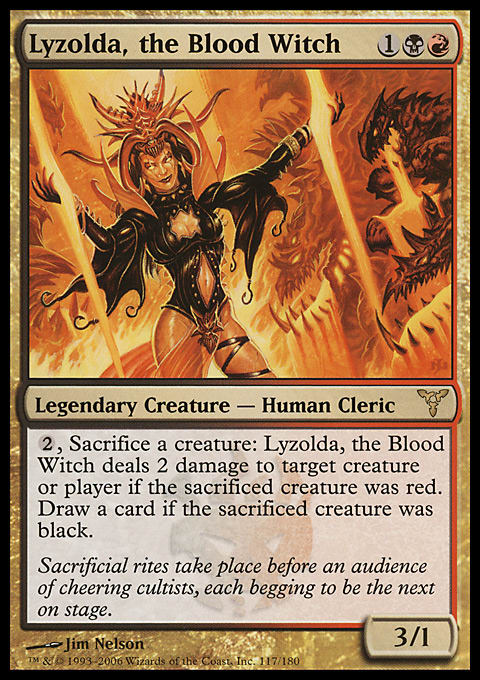From a design standpoint, the original Ravnica block’s guild system is where cycles met branding, and the results were striking. I could go on about the awesomeness of Ravnica, but you probably agree already anyway; plus, Magic’s currently in that world again. I don’t need to belabor the points. But I should review the cycles.
A reminder of the parameters:
- I’m looking at horizontal cycles (Titans), not vertical cycles (Penumbra Bobcat/Penumbra Kavu/Penumbra Wurm). They need at least five cards, though they don’t have to be in five colors.
- No all-common cycles. They tend to be boring.
- No land/mana cycles. They tend to be too similar for my purposes. Besides, every dual land is good.
I’m grading each cycle on three categories:
- Playability – Does this cycle have any cards people want to play?
- Depth – Was it hit-and-miss or strong overall?
- Resonance – Memorable cycles should be able to pass the flavor test, although some cycles are mechanical and are not intended to have shared flavor. Still, making all the cards cost the same, have similar names, or share other characteristics can make a cycle memorable when it otherwise wouldn’t be.
In the case of Ravnica block, many cycles were spread across all three sets. Several cycles were mechanical, but cycles were integral to the block flavor, so they fare better than, say, the Skull Collector cycle in Saviors of Kamigawa.
The Guildmages
(Azorius Guildmage, Dimir Guildmage, Rakdos Guildmage, Gruul Guildmage, Selesnya Guildmage, Orzhov Guildmage, Izzet Guildmage, Golgari Guildmage, Boros Guildmage, Simic Guildmage)
Playability: B+
Depth: A−
Resonance: A−
This is among the most memorable uncommon cycles ever. For starters, there’s the novelty of hybrid mana, and the mana costs are tight across the cycle for these 2/2s. Each Guildmage’s abilities cost the same except for a color difference. None of them have flavor text—I wish a cycle this iconic had room for them—but their symmetry and surprising depth make them a fantastic introduction to the guild system. (As best as I can remember, this cycle was also the first point at which the colors’ Wizard/Shaman distinctions was noticeable.)
Izzet Guildmage made an infinite iteration combo with Lava Spike spliced onto a Desperate Ritual; it wasn’t hard to put together, and it showed up in Standard for a while. Rakdos Guildmage was part of Standard aggro decks as an efficient beater that gave the deck extra late game. Many of the others have been casual staples. Orzhov, Golgari, and Gruul Guildmages I probably have seen the least, but they’re still effective. My favorites for multiplayer are Azorius Guildmage, who’s in my W/U Pure Reflection/Unnatural Selection/Wizard tribal deck, and Selesnya Guildmage, who’s in my Masako the Humorless/Glare of Subdual deck.
Azorius, Boros, Golgari, Orzhov, and Selesnya Guildmages were sufficiently popular for reprints in the Commander preconstructed decks. Putting several multiplayer-friendly abilities in the cycle has sustained its visibility, and it would be hard to play casual Magic for more than two years without seeing a Guildmage pop up.
The Guild Leaders
(Grand Arbiter Augustin IV, Szadek, Lord of Secrets, Rakdos the Defiler, Borborygmos, Chorus of the Conclave, Ghost Council of Orzhova, Niv-Mizzet, the Firemind, Sisters of Stone Death, Razia, Boros Archangel, Momir Vig, Simic Visionary)
Playability: A-
Depth: A−
Resonance: B
These are all casual staples, and Ghost Council of Orzhova was a Standard force, in part because it was designed while combat damage went on the stack. I’ve seen all of these at different points and died to them horribly at those points. Not all have maintained their reputations equally, in large part because Commander has shone its singleton blessings on some (Augustin/Niv-Mizzet/Momir Vig) more than others (Rakdos/Ghost Council), but you don’t relish seeing any of them on the battlefield.
The main resonance problem here and with the guild VPs below is that there’s a competing cycle in play. The big legends all have CCDD mana costs: 2 mana of one color and 2 of another. But the guild leaders aren’t all in this category. Augustin and Momir Vig belong to the VPs if you’re looking at mana cost and size, but in the storyline, they’re the leaders, so they go here. That small confusion brings them down—keeping them straight is one of those things I tend to have to look up every time—but that doesn’t stop them from being good cards.
The Guild VPs
(Isperia the Inscrutable, Circu, Dimir Lobotomist, Lyzolda, the Blood Witch, Ulasht, the Hate Seed, Tolsimir Wolfblood, Teysa, Orzhov Scion, Tibor and Lumia, Savra, Queen of the Golgari, Agrus Kos, Wojek Veteran, Experiment Kraj)
Playability: A−
Depth: B+
Resonance: B
The Rick Bruiser to the guild leaders’ Nick Bruiser, these are not quite as good as their bosses, and to my knowledge, their utility has been restricted to casual. But they’ve all been hitting kitchen tables plenty themselves, and although Circu suffers as a commander, Teysa and Savra attain deck captaincy more often than the Ghost Council or Sisters. I’m fondest of Isperia, Tolsimir, and Experiment Kraj, as I love naming cards, making Voja (how much better would Ravnica block have been with token cards in booster packs?), and doing awesome things, respectively.
In a 2008 three-player game, one of my opponents was about to go infinite with the Morselhoarder/Sinking Feeling/Presence of Gond combo. The trouble was that, thanks to Experiment Kraj, I had the entire combo on my side as long as I could keep a +1/+1 counter on Morselhoarder. Given that the combo involved putting -1/-1 counters on Morselhoarder, it was all a bit weird, but in the end, I was able to respond to his combo with my combo. It was confusingly wonderful.
There aren’t stories as glorious with the others, but they’re still considered fun times. Again, there’s a resonance hiccup, but this cycle has a fine reputation.
The Guild Artifacts
(Walking Archive, Bloodletter Quill, Rakdos Riteknife, Gruul War Plow, Crown of Convergence, Moratorium Stone, Mizzium Transreliquat, Plague Boiler, Sunforger, Evolution Vat)
Playability: A−
Depth: B
Resonance: B−
My first sanctioned tournament was Alabama States 2005. I lost every game with a deck based around Elder Pine of Jukai. (Go figure.) Several writers expected Boros aggro, so I built my deck to deal with it. Right colors, wrong deck style, as a Sunforger control deck left my face unrecognizable.
Sunforger was an immediate hit, while others of the cycle have had sketchier histories. Moratorium Stone and Evolution Vat tend not to be worth it. I think Rakdos Riteknife is awful, though some players like it. I’ve seen Walking Archive in a graft deck and go nuts, and Plague Boiler’s surprisingly cheap given its Commander utility, but most everything else exists to apathetic response.
The resonance is hurt by being too subtle; I don’t think it’s obvious each guild has exactly one artifact linked to it. There’s one creature, two pieces of Equipment, and seven other artifacts involved. After the guild-associated cycles we’ve looked at, these feel underwhelming. Nonetheless, there’s some fun to be had with them. Take my Crown of Convergence deck, for example:
"My Crown of Convergence Deck, For Example"
- Creatures (23)
- 3 Mycoid Shepherd
- 4 Ancient Spider
- 4 Giant Dustwasp
- 4 Loxodon Hierarch
- 4 Mystic Enforcer
- 4 Sabertooth Nishoba
- Spells (12)
- 4 Congregation at Dawn
- 4 Verdant Succession
- 4 Crown of Convergence
- Lands (25)
- 10 Plains
- 11 Forest
- 4 Selesnya Sanctuary
The object is to give resilience to G/W midrange via Verdant Succession. Crown of Convergence pumps most of the team into Mycoid Shepherd’s life-gain if that’s necessary, Loxodon Hierarchs can sacrifice themselves to fetch other Loxodon Hierarchs for more life-gain, Congregation at Dawn can turn a deactivated Crown of Convergence into an activated one for a combat trick, and there’s a flying finisher/early play in Giant Dustwasp, whose greenness is a plus in this deck. It’s not a complicated deck, but its constant stream of midrange delights and reasonable amounts of life-gain make it tough in multiplayer. Plus, Giant Dustwasp.
The Rusalkas
(Martyred Rusalka, Drowned Rusalka, Plagued Rusalka, Scorched Rusalka, Starved Rusalka)
Playability: C−
Depth: B
Resonance: B−
These are 1/1 Spirits for 1 mana with activated abilities involving paying a mana and sacrificing a creature. Some of them were okay in Limited, but that’s most of their upside. Spirit tribal decks can do better, sacrifice decks can do better, and multiplayer decks can do better. It’s easy to identify the cycle as a cycle, but that’s the only redeeming feature. (Plagued Rusalka was reprinted in Duel Decks: Izzet vs. Golgari. No idea why.)
And although easy-to-identify cycles can earn high marks on resonance, that old problem of strangely-divided-artist-credits shows up here, docking the cycle some. Alex Horley-Orlandelli illustrated Martyred Rusalka and Plagued Rusalka; they look like a pair. Dany Orizio illustrated Drowned Rusalka and Starved Rusalka; they also look like a pair. Then there’s Luca Zontini, who illustrated Scorched Rusalka. I tend not to like half-and-half art credits; you look at a couple cards in a cycle and think you know the basic look, and then you look at the others and wonder why two look the same. It’s just hard to become excited about this cycle in any way.
The Hunted Creatures
(Hunted Lammasu, Hunted Phantasm, Hunted Horror, Hunted Dragon, Hunted Troll)
Playability: B
Depth: B+
Resonance: B+
On the strange side as cards, there’s no mistaking this cycle. Each creature is well above par for its mana cost, apart from giving creatures to your opponent. Hunted Lammasu (the game’s only non-changeling Lammasu) gives a Horror, Hunted Horror gives two Centaurs, Hunted Dragon gives three Knights, Hunted Troll gives four Faeries, and Hunted Phantasm gives five Goblins. (Would a five-color Hunted creature give six things?) Hunted Dragon is a prime 5-drop in Dragon decks, Hunted Horror is a fantastic base for The Mimeoplasm, and Hunted Phantasm is an optimal use of Leyline of Singularity. In every case, if you can mitigate the drawback or make a useful friend in with the tokens you’re giving away, these are powerful given their speed. They’re not amazing or in line for Most Popular Ravnica Cycle, but they’re definitely fun.
The Nephilim
(Yore-Tiller Nephilim, Glint-Eye Nephilim, Dune-Brood Nephilim, Ink-Treader Nephilim, Witch-Maw Nephilim)
Playability: B+
Depth: B
Resonance: A−
The only spells of exactly four colors, the Nephilim are easily remembered, if not easily playable or easily distinguishable from each other. Four-color mechanics are undefined, so it’s not as though you can make a card feel like its colors and not the missing one unless they have protection from the missing color a la Oversoul of Dusk. Their flavor texts discuss their awakenings with events that match their abilities; it’s an important touch.
The main issue is that they tend to be tough to use. Ink-Treader Nephilim enables all manner of combos; my favorite is a friend’s aiming Undying Flames at it, creating a bajillion copies that will epically recur every turn (the original copies have epic, which means the copies copy themselves on upkeep). Yore-Tiller Nephilim has a fantastic ability, but it’s on a 2/2 body. That’s the problem with most of these—except for Witch-Maw Nephilim, which can grow big quickly, they need support to be useful, and they’re usually not worth the work.
But Dune-Brood Nephilim makes Sand tokens. How much playability do you need when you can make Sand tokens? Not a whole lot—probably more than this, but not a whole lot.
The Leylines
(Leyline of the Meek, Leyline of Singularity, Leyline of the Void, Leyline of Lightning, Leyline of Lifeforce)
Playability: A
Depth: C−
Resonance: A
The Leylines broke all the rules by letting you start the game with them on the battlefield. This uniqueness, combined with some high-profile cards, makes them the easiest Ravnica-block cycle to remember that isn’t guild-aligned. That uniqueness spawned another cycle of Leylines in M11 and partially inspired the Chancellor cycle of New Phyrexia, so it’s a solid legacy.
And Legacy is the main reason the playability is so high, as Leyline of the Void is the most accomplished dredge fighter in history. Others have had their turns, but the Leyline is the only one that can induce concessions before lands happen. The other Leylines don’t match the Void’s prowess, however. Leyline of Singularity does funny things, Leyline of the Meek was decent until Intangible Virtue, and the other two haven’t been useful for much. Still, even as people can’t remember half the original Leylines do, they remember their hook, and as long as dredge is in tournaments, the Leylines will see air time.
Conclusion
As much as Ravnica: City of Guilds block was marketed by its huge cycle of guilds, it lived and died on them as well. Thankfully for all concerned, they hit the marks they most needed to hit, much like Invasion with the legendary Dragons, and everyone lived happily ever after.
But that’s only half the block’s cycles. Next time will cover the other half.































